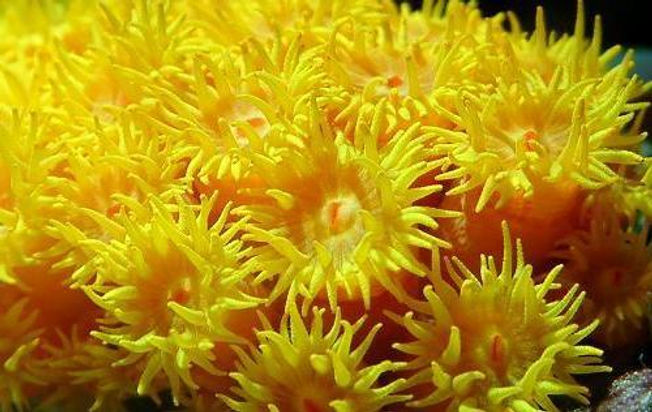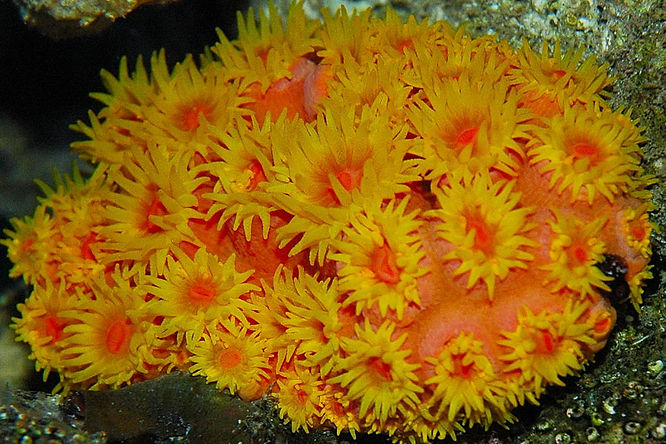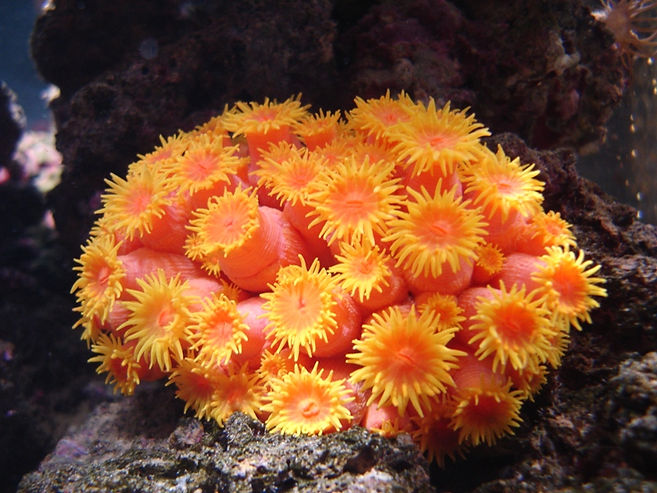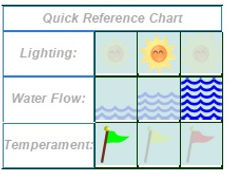Porous Cup Coral, Orange Coral, Balanophyllia Coral
Balanophyllia bairdiana
The Cup Coral makes its debut... this tiny delicate beauty is a very recent arrival, though still quite rare!
The Cup Coral Balanophyllia bairdiana is a new species in the reef aquarium world, becoming available in just the last couple years. This is a solitary coral, with the colony consisting of a single corallite. But they will sometimes grow close together, even attaching together, making a small cluster of fused individuals. Other common names the B. bairdiana are known for are Porous Cup Coral, Balanophyllia Coral, and Orange Coral.
As the name Cup Coral implies, these small corals start out in a cup shape, but over time they can become more oval and elongated, some will even form a figure eight shape. The corallite of these tiny beauties generally reach less than an 1.2" (3 cm) in diameter, and is usually less than 1/2" (1 cm). The corallite is covered with a weak tissue, called the coenosteum that is porous and grainy, or spongy feeling. Their stalks are long and usually attached to the substrate. In the wild they can have encrusting organisms, such as sponges, sea squirts, and bryozoans, growing on them around the base. They are ahermatypic, which means they don't contribute to reef building.
The B. bairdiana have a delicate look about them. They come in a variety of colors including red, orange, pink, lime green, green, or brown. Their beautiful tentacles are usually translucent and can extend as much as 1" (2.5 centimeters) in all directions. They have a spotty appearance due to little wart-like growths on them that contain sticky spirocysts and stinging nematocysts that aid in capturing prey. These pretty tentacles emerge to feed mostly at night, or under very dim lighting conditions.
The Cup Coral can be moderately difficult to care for. This is due to it needing an extreme amount of food for its captive survival. Though it requires only a low to moderate water movement, the amount of nutrients introduced to the aquarium require good filtration and substantial water changes. It is only recommended for the advanced aquarist. Its success depends on a dedicated aquarist who can provide the right environment and the on-going care of this beautiful coral.
Scientific name Family: Dendrophylliidae
Species: Balanophyllia bairdiana
Distribution / Background :
Here is a brief .. For more information click on the primary name ..
Balanophyllia Coral Information: The Balanophyllia genus was described by Wood in 1844. There are 62 species; a few of the more familiar ones are the Cup Coral B. Bairdiana, Orange Cup Coral B. elegans, Wart Coral B. europaea,Blushing Star Coral or Golf Ball Coral B. grandis, Scarlet Star Coral or Gold Star Coral B. regia, B. cedrosensis, B. calyculus, B. pittieri, and B. floridana. Common names the Balanophyllia species are known for are Porous Cup Coral, Balanophyllia Coral, Orange Coral, Orange Cup Coral, Gold Star Coral, Scarlet Star Coral, Gold Star Coral, Golf Ball Coral, Blushing Star Coral, and Wart Coral.
This genus represents pretty much all waters and oceans; with many subtropical species, a few tropical species and some temperate ones. These corals are referred to as azooxanthellate or non-photosynthetic corals, which means they only survive with foods, and lighting has no affect on their growth. They are non-reef building corals, or ahermatypic. This genus has not been propagated in captivity.
The Cup Coral Balanophyllia bairdiana was described by Milne-Edwards and Haime in 1848. Some other common names these corals are know for are Porous Cup Coral, Balanophyllia Coral, and Orange Coral.
Where Balanophyllia Corals Are Found: The Balanophyllia genus are found in the Eastern Pacific in the USA and Canadian coasts, subtropical parts of the Mediterranean Sea, Western Atlantic, on the coasts of USA & Canada, Western Central Pacific, Philippines, and Australian coasts from 1 to 420 feet (1 - 128 m). The B. bairdiana are found in the Western Central Pacific in the Philippines, and in the waters of south-eastern Australia.
Balanophyllia Coral Habitat: The B. bairdiana are found on reef habitats, most commonly on the roofs of caves but occasionally in other dimly lit areas. They live in tropical waters, generally at depths to 90 feet (28 m). The Australian specimens however, are reportedly found at depths from 16 to 246 feet (5 - 75 m).
Status :
The B. bairdiana is not on the IUCN Red List of Endangered Species.
Description :
What do Balanophyllia Corals look like: The B. bairdiana start out in a cup shape, but over time they can become more oval and elongated, some will even form a figure eight shape. Their corallites generally reach less than 1.2" (3 cm) in diameter, and is usually less than 1/2" (1 cm). Corallites are covered with a weak tissue, called the coenosteum that is porous and grainy, or spongy feeling. Their stalks are generally long and usually attached to the substrate. In the wild they can have encrusting organisms, such as sponges, sea squirts, and bryozoans, growing on them around the base. They are ahermatypic, which means they don't contribute to reef building.
The Cup Coral B. bairdiana have a delicate look about them. They come in a variety of colors including red, orange, pink, lime green, green, or brown. Their beautiful tentacles are usually translucent and can extend as much as 1" (2.5 centimeters) in all directions. They have a spotty appearance due to little wart-like growths on them that contain sticky spirocysts and stinging nematocysts that aid in capturing prey. These pretty tentacles emerge to feed mostly at night, or under very dim lighting conditions. Life span is unknown.
Some other Balanophyllia species:
-
Balanophyllia elegansThe Orange Cup Coral is found in subtropical waters on the western coast of the United States and in British Columbia. They inhabit low inter tidal zones at 26 to 32 feet (8 - 10 m). They have yellow to orange tissue.
-
Balanophyllia europaeaThe Wart Coral is the only species of the Balanophyllia genus that is endemic to the Mediterranean Sea. It is quite odd, with clear tentacles and tissue, enabling you to see the skeletal structure. They can be kept successfully in the aquarium for many years, but they must be introduced to the aquarium with their substrate intact.
-
Balanophyllia grandisThe Blushing Star Coral or Golf Ball Coral are found in the subtropical waters of the Caribbean in caves and under overhangs. It is the largest species found in the western Atlantic and have red tissue.
-
Balanophyllia regiaThe Scarlet Star Coral or Gold Star Coral are found in the subtropical waters of the southwest coast of England, the southwest Pembrokeshire, and the Scilly Isles. It is attached to rocks in caves, overhangs, or surge gullies from 1 to 32 feet (0 - 10 m). They are a clearish golden yellow, yellow, orange or red. The polyps are short and thick at the bottom, tapering to a point at the tip.
-
Balanophyllia calyculusThis coral are found in the subtropical waters around the entire Australian coastline from 3 - 420 feet (1 - 128 m) in depth on roofs of caves. They can be orange with orange tentacles, or purple and white with clearish white tentacles, or a translucent brown or green.
Aquarium Care :
Typical water changes of 20% a month, 10% biweekly, or 5% weekly are needed. It has been noted that 5% weekly water changes replenish many of the needed additives. Frequent water changes help to supply trace elements, but with higher concentrations of coral with calcareous skeletons, there may be a need put in additional additives to maintain proper levels for good growth.
The following water supplements are suggested for Balanophyllia species:
-
Calcium: 400 to 450 ppm. If a large poly stony (LPS) coral does not have enough calcium, it will not grow. (Seachem makes a calcium additive that states 385 as sufficient)
-
Alkalinity: 3.2 TO 4.8 MEQ/L (8 to 11 dKh, 10 is recommended)
-
Phosphates: 0, zero. Phosphates are the worst of all and all corals hate them.
-
Magnesium: 1200 - 1350 minimum. Magnesium makes calcium available, so if your calcium is low, check your magnesium levels before adding any more calcium.
-
Strontium: 8 - 10
Aquarium Parameters :
A well-feed live rock/reef environment is what is needed for the Cup Coral, along with some fish for organic matter production. A mature tank is recommended. For the subtropical and temperate species, a chill will be needed.
They need to have a low to moderate water movement. They are tolerant of lighting in the aquarium, but will only extend their tentacles to feed at night, or under very dim lighting conditions. A strong skimmer is recommended to take care of the nutrient load added by the heavy feedings needed for these corals.This is a semi-aggressive species, so provide adequate space between species.
-
Minimum Tank Size / Length: 10 gallons (38 L) or larger
-
Marine Lighting: Any
-
Temperature: 72° - 79° F (22° - 26° C). (55° - 68° F (13° - 20° C) for subtropical species)
-
Salinity / Specific Gravity: 1.023 - 1.027
-
Water Movement: Low to moderate
-
Water Region: Bottom of the aquarium, or in cave-like structures
-
Sex - Sexual differences Differences are unknown
Difficulty of Care :
Balanophyllia Coral Care: In general the Balanophyllia genus can be moderately difficult to care for. This is due to needing an extreme amount of food for captive survival. The Cup Coral B. bairdiana requires only a low to moderate water movement, the amount of nutrients introduced to the aquarium require good filtration and substantial water changes. It is only recommended for the advanced aquarist. Its success depends on a dedicated aquarist who can provide the right environment and the on-going care of this beautiful coral.
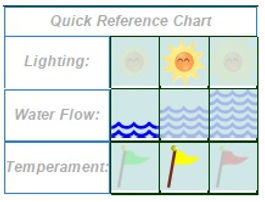

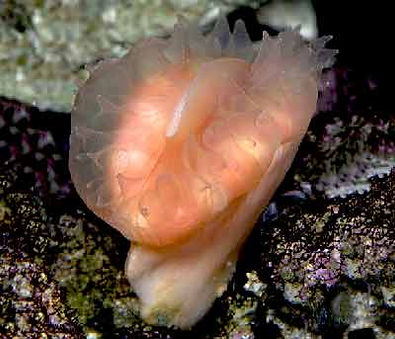
Orange Cup Coral, Sun Coral, Orange Polyp Coral
Tubastrea faulkneri
The brilliant Orange Sun Coral is a prized photographic subject for both hobbyists and professionals!
The Orange Sun Coral Tubastraea faulkneri is so gorgeous, it often is found on the covers of coffee table books and books that specialize in corals. It has been the winning subject of photograph competitions, and it is easy to see why. With a bright yellow against a bright orange, it is so gaudy it is spell binding. Other common names these corals are know for are Orange Cup Coral, Sun Coral, Orange Polyp Coral, Rose Sun Coral, Golden Cup Coral, Sun Flower Coral, and Tube Coral.
The corallites of the Orange Sun Coral, the hard round, tubular structures that the polyps live in. The corallites are covered with a tissue, called the coenosteum. The fleshy tentacles of its polyps are bright yellow with the coenosteum having a bright orange color, and the very center of the polyps are also bright orange. They extend their polyps mostly during the evening hours, though they can be coaxed out during the day if food is present. During the day the coral is completely withdrawn and only the bright orange coenosteum is visible, making it look like a ball with raised round flat nubs.
The Tubastraea genus can form colonies about the size of a fist in diameter. These will often grow on each other, forming a more complex and larger 'community'. Some branch into 40" (1 m) treelike structures. The Orange Sun Coral can form colonies around 6" (15 cm) in diameter. They are slow growers, only adding about 1.6" of growth per year. The T. faulkneri are also ahermatypic, which means they don't contribute to reef building.
Lighting has no affect on the growth of the Orange Sun Coral. They are referred to as azooxanthellate, or non-photosynthetic corals. This means that, unlike most other large polyp stony (LPS) corals, they do not have a symbiotic relationship with the marine algae zooxanthellae. They survive in the wild with foods such as plankton they take from the water column. Some species also eat small fish. Like soft corals, the T. faulkneri can also produce bio-active compounds. Some of these can be damaging to the larvae of some corals, but one of these compounds, called tubastrine, has anti-viral properties.
The Orange Sun Coral can be easy to moderate to care for, depending on the dedication of the aquarist. They can be very difficult for the aquarist who does not have the time for daily feedings, or adequate filtration. Yet they can be easy for aquarists with a strong skimmer and who are dedicated to following through with the care of this beautiful coral.
The T. faulkneri have a voracious appetite and will multiply for you if you can keep up with their feeding requirements. Light will not harm the Orange Sun Coral, but they do not have a very good defense against algae. Algae grows fast in lit areas, and if algae is allowed to grow on the T. faulkneri, it will die eventually. Strong water movement is a must. Putting the coral in areas under ledges that usually do not have the water flow they need, can also cause algae growth.
Scientific name Family: Dendrophylliidae
Species: Tubastraea faulkneri
Status The T. faulkneri is not on the IUCN Red List of Endangered Species.
Foods / Feeding :
Tubastraea Coral Feeding: The Tubastraea genus are referred to as azooxanthellate, or non-photosynthetic corals. This means that, unlike most other large polyp stony (LPS) corals, they do not have a symbiotic relationship with the marine algae zooxanthellae. To feed they capture planktonic organisms, food particles from the water column, and can absorb dissolved organic matter. Some also eat small fish.
In captivity, the Orange Sun Coral needs to be fed decent sized foods like enriched live or defrosted, or freeze dried adult brine shrimp, mysis shrimp, and other similar sized prey. Soak the food in a vitamin supplement, since that seems to help the coral reproduce faster. If they are well fed, they get a "bloated" look. Feed daily.
New colonies may need the juice of the shrimp wafting across the tops of their closed polyps for a few nights before they start to feed. Be patient and persistent since this can take up to 2 weeks. Feeding the same time each evening will get the best response. These corals will stop extending their tentacles and gradually waste away if they are not fed.
There are several ways to approach feeding your Tubastraea, so they can hold onto the food.
-One way is to take the coral out of the tank into a container with warm tank water (or float the container in the tank to keep it warm) and feed the polyps a high concentration of food. After the coral has fed, it can be put back into the tank, and the fouled container of water discarded. This option will help keep the water quality high. Remember to wiggle the coral so the polyps pull in before removing.
-The second way is to leave the coral in the tank. Put on a feeding "cap" to keep the food from blowing away, and also to keep shrimp and fish from taking the food out of the polyp's mouth.
-The third choice is to simply turn off the pumps. But remember to turn them back on after they have fed.
Aquarium Care :
Typical water changes of 20% a month, 10% biweekly, or 5% weekly are needed. It has been noted that 5% weekly water changes replenish many of the needed additives. Frequent water changes help to supply trace elements, but with higher concentrations of coral with calcareous skeletons, there may be a need put in additional additives to maintain proper levels for good growth. Trace minerals and iodine may be added
The following water supplements are suggested for Tubastraea species:
-
Calcium: 380 to 430 ppm. If a large poly stony (LPS) coral does not have enough calcium, it will not grow. (Seachem makes a calcium additive that states 385 as sufficient)
-
Alkalinity: 3.5 MEQ/L (8 to 12 dKh, 10 is recommended)
-
Phosphates: 0, zero. Phosphates are the worst of all and all corals hate them.
-
Magnesium: 1200 - 1350 minimum. Magnesium makes calcium available, so if your calcium is low, check your magnesium levels before adding any more calcium.
-
Strontium: 8 - 10
Aquarium Parameters :
A well-feed live rock/reef environment is what is needed for your Orange Sun Coral, along with some fish for organic matter production. A strong skimmer is recommended to take care of the nutrient load added by the heavy feedings needed for these corals. A mature tank is recommended.
Be sure to have a strong water movement. Tubastraea species are tolerant of lighting in the aquarium. This is a peaceful species, but other corals may not be, so provide adequate space between species.
-
Minimum Tank Size / Length: 10 gallons (38 L) or larger
-
Marine Lighting: Any
-
Temperature: 74° - 83° F (23° - 28° C)
-
Salinity / Specific Gravity: 1.023 - 1.025
-
Water Movement: Strong
-
Water Region: All areas of the aquarium, where it's easy to feed
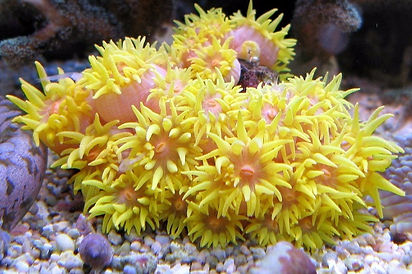
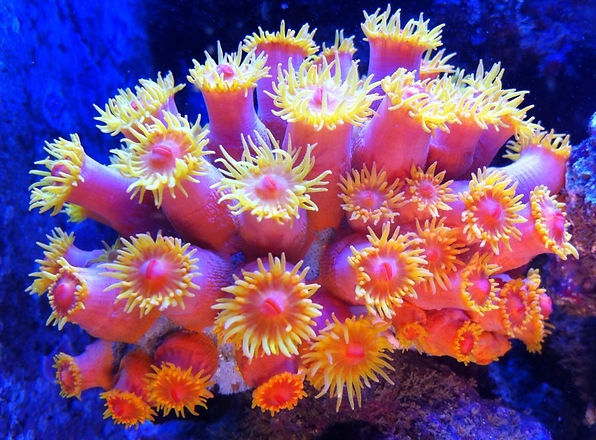
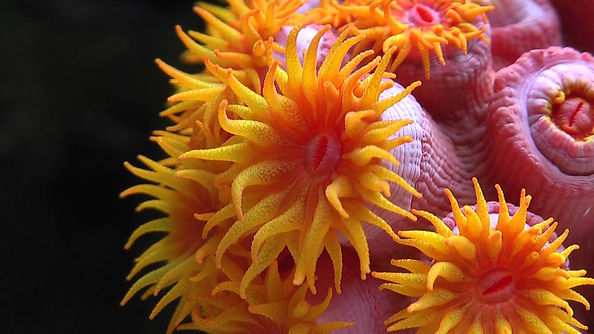
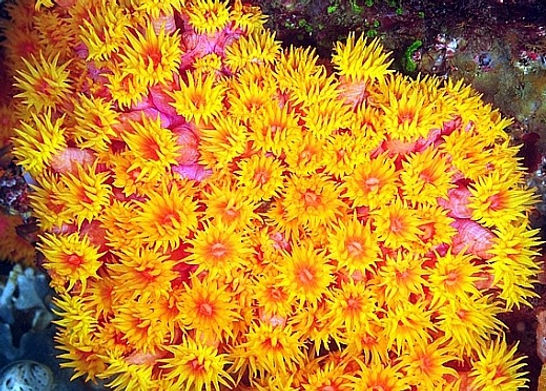

Vase Coral, Scrolling Turbinaria Coral, Turban Coral
Yellow Scroll Coral, Yellow Lettuce Coral, Yellow Turbinaria
Turbinaria reniformis
The colorful Scroll Coral is one of the most unique Tubinaria species, and is also one of the hardier ones!
The Scrolling Tubinaria Coral Turbinaria reniformis is one of the most recognized of the Turbinaria genus. In mature specimens, their scroll-like or whorled shape can be either vertical or more horizontal, depending on the depth in which they are found. Specimens found at deeper levels have a plate like or flatter, horizontal appearance. That can change to a scroll like, upright shape in shallower water with brighter lighting. These characteristic Turbinaria shapes are reflected in some of the Scroll Coral's other common names like Vase Coral, Turban Coral, Scrolling Turbinaria Coral, and Yellow Lettuce Coral.
The Turbinaria species take on various characteristic shapes, depending on the depth at which they are found. Their shapes include vase, plate, and columnar, yet they are quite adaptable. They will robustly change shape with a change in environment. If one were to transplant a shallow dwelling species to deeper levels, or visa versa, they will actually change shape to make the most out of the lighting in each habitat.
Besides having various shapes, Turbinaria corals also have variations in their polyps. One side of any plate or column generally has polyps or at least tissue coverage. The color of the Scrolling Coral T. reniformis is usually a yellowish or greenish brown, usually with yellow polyps and a yellow edge. Some Scroll Coral specimens you may see in stores may not have as many polyps, due to lack of feeding, yet the polyps are still distinctly small and spaced, and so it is easy to identify.
The Turbinaria corals are much sought after for reef aquariums. Depending on the variety, Turbinaria species can be grouped as small polyp stony (SPS) corals or as large polyp stony (LPS) corals. The Scrolling Turbinaria Coral T. reniformis has smaller polyps with calices (opening of the corallite) that are only 1.5 to 2 mm diameter. Yet they are most often grouped as an LPS corals, though you can find it occasionally listed as an SPS coral. Either way, theTurbinaria polyp expansion is a great indicator of the overall health of the aquarium, thus a great addition to most systems.
The Scroll Coral is fairly easy to maintain in an aquarium with good lighting and water quality. They are mostly friendly towards other corals, making them a popular choice with all levels of reef enthusiasts. They do have polyps, that when irritated can produce a hefty mucus net. If this mucus comes in contact with other corals, it can damage them. They have been known to reproduce in captivity, and captive bred specimens are generally more healthy and easier to maintain than wild caught.
Scientific name :
Family: Dendrophylliidae
Species: Turbinaria reniformis
Status :
The T. reniformis is not on the IUCN Red List of Endangered Species.
Foods / Feeding :
Turbinaria Coral Feeding: The Turbinaria genus, like other large polyp stony (LPS) corals, have developed several feeding strategies. Through a symbiotic relationship with a marine algae, known as zooxanthellae, they receive some of their nutrients. Turbinaria are the only genus in the Dendrophylliidae family that are symbiotic.They also capture planktonic organisms, food particles from the water column, and can absorb dissolved organic matter.
In captivity, although the Scroll Coral relies on lighting for their zooxanthellae, they also need to be fed a variety of other foods. Feed such foods as mysis shrimp, enriched baby brine shrimp, cyclopeeze, and finely minced silversides or other fish from the ocean that you can get at your grocery store. They need to be fed several times a week. Use good sense in determining how often your particular animal needs food. If their polyps start to disappear, then you are not feeding them enough.
Aquarium Care :
Typical water changes of 20% a month, 10% biweekly, or 5% weekly are needed. It has been noted that 5% weekly water changes replenish many of the needed additives. They also benefit from strontium and trace elements. Frequent water changes help to supply trace elements, but with higher concentrations of coral with calcareous skeletons, there may be a need put in additional additives to maintain proper levels for good growth.
The following water supplements are suggested for Turbinaria species:
-Calcium: 385 to 425 ppm. If a large poly stony (LPS) coral does not have enough calcium, it will not grow.
-Alkalinity: 8 to 12 dKh
-Phosphates: 0, zero. Phosphates are the worst of all and all corals hate them.
-Magnesium: 1350 minimum. Magnesium makes calcium available, so if your calcium is low, check your magnesium levels before adding any more calcium.
-Strontium: 8 - 10
Aquarium Parameters :
A live rock/reef environment with a sandy substrate is what is needed for your Scroll Coral, along with some fish for organic matter production. A mature tank is recommended.
Be sure to have proper water movement and provide sufficient lighting.Turbinaria species can be tolerant of several lighting conditions, though a moderate to high light is preferred by the T. reniformis. Along with adequate lighting, provide a moderate and turbid, or a surging water movement for the best health. This is a peaceful species, but other corals may not be, so provide adequate space between species.
-
Minimum Tank Size / Length: 100 gallons (380 L) or larger
-
Marine Lighting: Moderate to high
-
Temperature: 74° - 83° F (23° - 28° C)
-
Salinity / Specific Gravity: 1.023 - 1.025
-
Water Movement: Moderate and turbid, or surging
-
Water Region: Bottom to middle of the aquarium
-
Sex - Sexual differences Differences are unknown

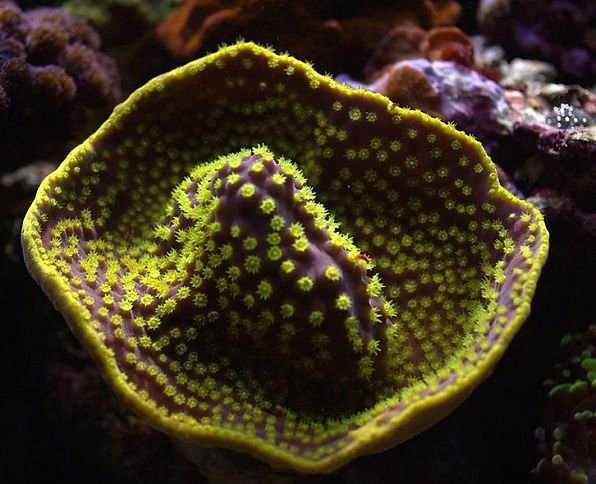
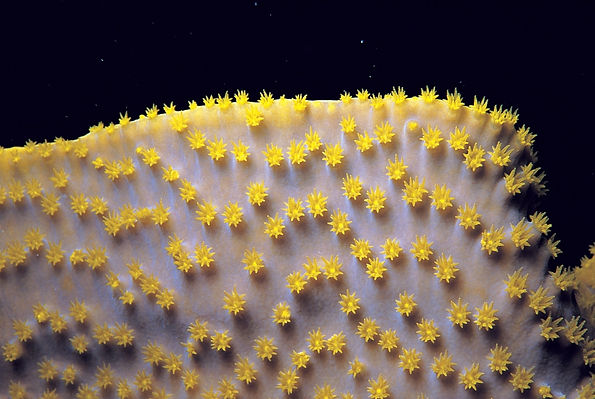
Cup Coral, Chalice Coral, Pagoda Cup Coral
Green Cup Coral, Column Coral, Bowl Coral, Octopus Coral
Turbinaria peltata
The Turban Coral, a favorite of all the Turbinaria, loves to extend its polyps both day and night!
The handsome Turban Coral Turbinaria peltata is a definite favorite from the Turbinaria genus. The corallites of its skeletal structure are knobby as opposed to an 'ant hill' tubular type, and they are close together. Its polyps are big and frilly, covering the underlying skeleton so well that the coral almost looks furry. A coral you may see at the stores may not have as many polyps, due to lack of feeding, yet they are still quite large making it easy to identify. After feeding as needed, the polyp numbers will exploded, making it one of your favorite corals.
The Turbinaria species take on various characteristic shapes depending on the depth at which they are found. They will robustly change shape with a change in environment. If one were to transplant a shallow dwelling species to deeper levels, or visa versa, they will actually change shape to make the most out of the lighting in each habitat.
Turban Corals T. peltata are typically sold in the "cup" form, yet again depending on the depth that they are captured, they can become columnar in shape. The characteristic Turbinaria shapes are reflected in the Turban Coral's other common names including Cup Coral, Pagoda Cup Coral, Green Cup Coral, Chalice Coral, Column Coral, Bowl Coral, Octopus Coral, Plate Coral, Vase Coral, Disk Coral, Platter Coral, and Saucer Coral.
Besides having various shapes, Turbinaria corals also have variations in their polyps. One side of any plate or column generally has polyps or at least tissue coverage. The Turban Coral has large fleshy polyps with calices (opening of the corallite) that are 3 to 5 mm in diameter. The color of the T. peltata can be brown, yellow, gray, and greenish gray blue with some cream.
The Turbinaria corals are much sought after for reef aquariums. Depending on the variety, Turbinaria species can be grouped as small polyp stony (SPS) corals or as large polyp stony (LPS) corals. T. peltata has calices (opening of the corallite) that are 3 to 5 mm in diameter, so they are most often grouped as an LPS coral. Others, such as theYellow Cup Coral Turbinaria frondens, which has much smaller polyps with its calices being only 1.5 to 2.5 mm in diameter, are most often grouped as an SPS corals, though this can vary. Either way, the Turbinaria polyp expansion is a great indicator of the overall health of the aquarium, thus a great addition to most systems.
The Turban Coral is a great beginner's coral that delivers a high satisfaction rating. It is one of the easiestTurbinaria species to maintain in an aquarium with good lighting and water quality. Yet it doesn't need high lighting or special considerations. It just needs some water moving across it to help remove wastes. It also doesn't grow super fast, so won't outgrow its tank any time soon.
Turbinaria corals are mostly friendly towards other corals, making them a popular choice with all levels of reef enthusiasts. They do have polyps, that when irritated can produce a hefty mucus net. If this mucus comes in contact with other corals, it can damage them. They have been known to reproduce in captivity, and captive bred specimens are generally more healthy and easier to maintain than wild caught.
Scientific name Family: Dendrophylliidae
Species: Turbinaria peltata
Status :
The T. peltata is not on the IUCN Red List of Endangered Species.
Foods / Feeding :
Turbinaria Coral Feeding: The Turbinaria genus, like other large polyp stony (LPS) corals, have developed several feeding strategies. Through a symbiotic relationship with a marine algae, known as zooxanthellae, they receive some of their nutrients. Turbinaria are the only genus in the Dendrophylliidae family that are symbiotic.They also capture planktonic organisms, food particles from the water column, and can absorb dissolved organic matter.
In captivity, although the Turban Coral relies on lighting for their zooxanthellae, they also need to be fed a variety of other foods. Feed such foods as mysis shrimp, enriched baby brine shrimp, cyclopeeze, and finely minced silversides or other fish from the ocean that you can get at your grocery store. They need to be fed several times a week. Use good sense in determining how often your particular animal needs food. If their polyps start to disappear, then you are not feeding them enough.
Aquarium Care :
Typical water changes of 20% a month, 10% biweekly, or 5% weekly are needed. It has been noted that 5% weekly water changes replenish many of the needed additives. They also benefit from strontium and trace elements. Frequent water changes help to supply trace elements, but with higher concentrations of coral with calcareous skeletons, there may be a need put in additional additives to maintain proper levels for good growth.
The following water supplements are suggested for Turbinaria species:
-
Calcium: 385 to 425 ppm. If a large poly stony (LPS) coral does not have enough calcium, it will not grow.
-
Alkalinity: 8 to 12 dKh
-
Phosphates: 0, zero. Phosphates are the worst of all and all corals hate them.
-
Magnesium: 1350 minimum. Magnesium makes calcium available, so if your calcium is low, check your magnesium levels before adding any more calcium.
-
Strontium: 8 - 10
Aquarium Parameters :
A live rock/reef environment with a sandy substrate is what is needed for your Turban Coral, along with some fish for organic matter production. A mature tank is recommended.
Be sure to have proper water movement and provide sufficient lighting.Turbinaria species can be tolerant of several lighting conditions, though a moderate light is preferred. Along with adequate lighting, provide a moderate and turbid, or a surging water movement for the best health. This is a peaceful species, but other corals may not be, so provide adequate space between species.
-
Minimum Tank Size / Length: 100 gallons (380 L) or larger
-
Marine Lighting: Moderate
-
Temperature: 74° - 83° F (23° - 28° C)
-
Salinity / Specific Gravity: 1.023 - 1.025
-
Water Movement: Moderate and turbid, or surging
-
Water Region: Bottom to middle of the aquarium
Compatibility and Social Behaviors :
The T. peltata is peaceful towards other corals. However, if their polyps become irritated, they can produce a hefty mucus net. If this mucus comes in contact with other corals, it can damage them. So they do need adequate space between themselves and other corals.
Yellow Cup Corals do well in a mixed reef, a small polyp stony (SPS) coral tank, or a large polyp stony (LPS) coral tank. They do need to be kept away from contact with polyps of Zoanthid corals, and away from the sweeper tentacles of other corals. They are safe with reef safe fish, yet do not like to be walked on, sat on, or otherwise pestered by any kind of crab.
Sex - Sexual differences Differences are unknown
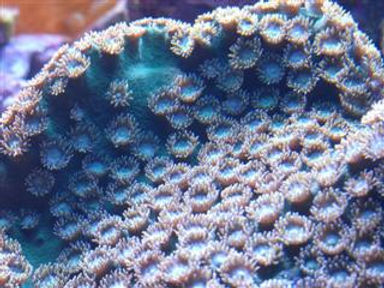
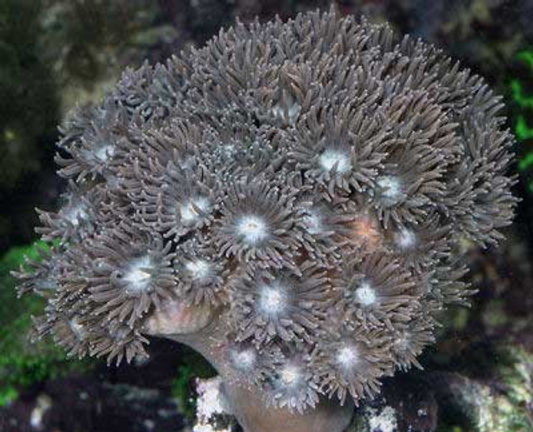

Cup Coral, Disc Coral, Scroll Coral, Pagoda Coral
Turbinaria frondens
A young Yellow Cup Coral looks just like its namesake... a beautiful bumpy yellowish cup!
The Yellow Cup Coral Turbinaria frondens is one good looking coral, both as a juvenile and as an adult. In the wild, young colonies start out in a cup shape. As they mature, the edges continue to grow upward on specimens living in shallower water, taking on more convoluted shapes like the "scroll" and vase shapes. The deeper dwelling specimens form horizontal plating to catch as much light as possible. These characteristicTurbinaria shapes are reflected in the Yellow Cup Coral's other common names; the Disc Coral, Cup Coral, Scroll Coral, and Pagoda Coral.
The Turbinaria species take on various characteristic shapes, depending on the depth at which they are found. Their shapes include vase, plate, and columnar, yet they are quite adaptable. They will robustly change shape with a change in environment. If one were to transplant a shallow dwelling species to deeper levels, or visa versa, they will actually change shape to make the most out of the lighting in each habitat.
Besides having various shapes, Turbinaria corals also have variations in their polyps. One side of any plate or column generally has polyps or at least tissue coverage. The color of the T. frondens can be yellowish brown, greenish brown, grayish green, tan, bluish-green, or cream.
The Turbinaria corals are much sought after for reef aquariums. Depending on the variety, Turbinaria species can be grouped as small polyp stony (SPS) corals or as large polyp stony (LPS) corals. The Yellow Cup Coral has small polyps with calices (opening of the corallite) that are only 1.5 to 2.5 mm in diameter. They are most often grouped as an SPS corals, though you can find it occasionally listed as an LPS coral. Yet others, such as the Scroll CoralTurbinaria reniformis which has even smaller polyps, with calices being only 1.5 to 2 mm, is often found grouped as an LPS coral, though again this can vary. Either way, the Turbinaria polyp expansion is a great indicator of the overall health of the aquarium, thus a great addition to most systems.
The Yellow Cup Coral is fairly easy to maintain in an aquarium with good lighting and water quality. They are mostly friendly towards other corals, making them a popular choice with all levels of reef enthusiasts. They do have polyps, that when irritated can produce a hefty mucus net. If this mucus comes in contact with other corals, it can damage them. They have been known to reproduce in captivity, and captive bred specimens are generally more healthy and easier to maintain than wild caught.
Scientific name Family: Dendrophylliidae
Species: Turbinaria frondens
Status
The T. frondens is not on the IUCN Red List of Endangered Species.
Foods / Feeding :
Turbinaria Coral Feeding: The Turbinaria genus, like other large polyp stony (LPS) corals, have developed several feeding strategies. Through a symbiotic relationship with a marine algae, known as zooxanthellae, they receive some of their nutrients. Turbinaria are the only genus in the Dendrophylliidae family that are symbiotic.They also capture planktonic organisms, food particles from the water column, and can absorb dissolved organic matter.
In captivity, although the Yellow Cup Coral relies on lighting for their zooxanthellae, they also need to be fed a variety of other foods. Feed such foods as mysis shrimp, enriched baby brine shrimp, cyclopeeze, and finely minced silversides or other fish from the ocean that you can get at your grocery store. They need to be fed several times a week. Use good sense in determining how often your particular animal needs food. If their polyps start to disappear, then you are not feeding them enough.
Aquarium Care :
Typical water changes of 20% a month, 10% biweekly, or 5% weekly are needed. It has been noted that 5% weekly water changes replenish many of the needed additives. They also benefit from strontium and trace elements. Frequent water changes help to supply trace elements, but with higher concentrations of coral with calcareous skeletons, there may be a need put in additional additives to maintain proper levels for good growth.
The following water supplements are suggested for Turbinaria species:
-
Calcium: 385 to 425 ppm. If a large poly stony (LPS) coral does not have enough calcium, it will not grow.
-
Alkalinity: 8 to 12 dKh
-
Phosphates: 0, zero. Phosphates are the worst of all and all corals hate them.
-
Magnesium: 1350 minimum. Magnesium makes calcium available, so if your calcium is low, check your magnesium levels before adding any more calcium.
-
Strontium: 8 - 10
Aquarium Parameters :
A live rock/reef environment with a sandy substrate is what is needed for your Yellow Cup Coral, along with some fish for organic matter production. A mature tank is recommended.
Be sure to have proper water movement and provide sufficient lighting.Turbinaria species can be tolerant of several lighting conditions, though a moderate light is preferred. Along with adequate lighting, provide a moderate and turbid, or a surging water movement for the best health. This is a peaceful species, but other corals may not be, so provide adequate space between species.
-
Minimum Tank Size / Length: 100 gallons (380 L) or larger
-
Marine Lighting: Moderate
-
Temperature: 74° - 83° F (23° - 28° C)
-
Salinity / Specific Gravity: 1.023 - 1.025
-
Water Movement: Moderate and turbid, or surging
-
Water Region: Bottom to middle of the aquarium
-
Sex - Sexual differences Differences are unknown
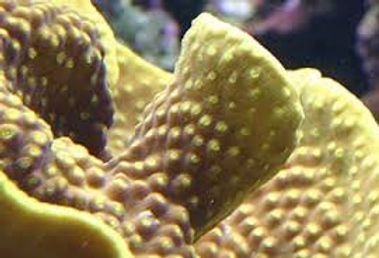
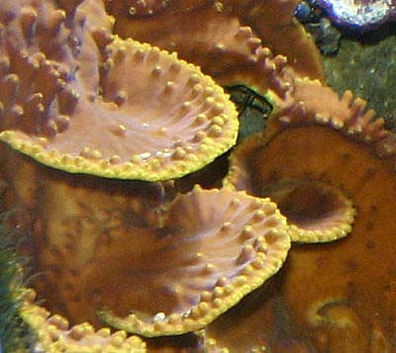
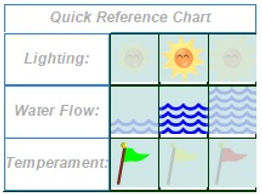
The pretty Yellow Sun Coral Tubastraea aurea is a nicely subdued color version of the Tubastraea genus. Another great photographic coral. The corallites of the T. aurea, the hard round, tubular structures that the polyps live in, are covered with a tissue called the coenosteum. The polyps have lightly colored tan or golden tentacles, with the center of the polyps being pale red-orange, and the coenosteum being yellow. It is similar to, yet a bit more delicate than, the slightly brighter Orange Sun Coral T. faulkneri, that has yellow polyps contrasted with bright orange centers and background .
Yellow Sun Corals extend their polyps tentacles mostly during the evening hours, though they can be coaxed out during the day if food is present. During the day the coral is completely withdrawn with only the yellow coenosteum being visible, making it look like a ball with raised round flat nubs. Other common names these corals are know for are Golden Cup Coral, Sun Coral, Sun Flower Coral, Tube Coral.
The Tubastraea genus can form colonies about the size of a fist in diameter. These will often grow on each other, forming a more complex and larger 'community'. Some branch into 40" (1 m) treelike structures. The Yellow Sun Coral can form colonies around 5" (13 cm) in diameter. They are slow growers, only adding about 1.6" of growth per year. The T. aurea are also ahermatypic, which means they don't contribute to reef building.
Lighting has no affect on the growth of the Yellow Sun Coral. They are referred to as azooxanthellate, or non-photosynthetic corals. This means that, unlike most other large polyp stony (LPS) corals, they do not have a symbiotic relationship with the marine algae zooxanthellae. They survive in the wild with foods such as plankton they take from the water column. Some species also eat small fish. Like soft corals, the T. aurea can also produce bio-active compounds. Some of these can be damaging to the larvae of some corals, but one of these compounds, called tubastrine, has anti-viral properties.
The Yellow Sun Coral can be easy to moderate to care for. If you want a really easy coral that only needs to be fed a few times a week and is low maintenance, it is best to leave this coral alone. The T. aurea can be easy to care for if the correct husbandry is followed. Yet they can be very difficult for the aquarist who does not have the time for daily feedings, adequate filtration, and regular substantial water changes..
The T. aurea have a voracious appetite and will multiply for you if you can keep up with their feeding requirements. Light will not harm the Yellow Sun Coral, but they do not have a very good defense against algae. Algae grows fast in lit areas, and if algae is allowed to grow on the T. aurea, it will die eventually. Strong water movement is a must. Putting the coral in areas under ledges that usually do not have the water flow they need, can also cause algae growth.
Scientific name Family: Dendrophylliidae
Species: Tubastraea aurea
Status :
The T. aurea is not on the IUCN Red List of Endangered Species.
Difficulty of Care :
Tubastraea Coral Care: The Tubastraea genus can be easy to moderate to care for depending on the dedication of the aquarist to feed the coral every day. Light will not harm them, but they do not have a very good defense against algae, which grows fast in lit areas. If algae is allowed to grow on the Yellow Sun Coral, it will die eventually. Putting the coral in areas under ledges that usually do not have the water flow they need can also cause algae growth. Strong water movement is a must.
Foods / Feeding :
Tubastraea Coral Feeding: The Tubastraea genus are referred to as azooxanthellate, or non-photosynthetic corals. This means that, unlike most other large polyp stony (LPS) corals, they do not have a symbiotic relationship with the marine algae zooxanthellae. To feed they capture planktonic organisms, food particles from the water column, and can absorb dissolved organic matter. Some also eat small fish.
In captivity, the Yellow Sun Coral needs to be fed decent sized foods like enriched live or defrosted, or freeze dried adult brine shrimp, mysis shrimp, and other similar sized prey. Soak the food in a vitamin supplement, since that seems to help the coral reproduce faster. If they are well fed, they get a "bloated" look. Feed daily.
New colonies may need the juice of the shrimp wafting across the tops of their closed polyps for a few nights before they start to feed. Be patient and persistent since this can take up to 2 weeks. Feeding the same time each evening will get the best response. These corals will stop extending their tentacles and gradually waste away if they are not fed.
There are several ways to approach feeding your Tubastraea, so they can hold onto the food.
-
One way is to take the coral out of the tank into a container with warm tank water (or float the container in the tank to keep it warm) and feed the polyps a high concentration of food. After the coral has fed, it can be put back into the tank, and the fouled container of water discarded. This option will help keep the water quality high. Remember to wiggle the coral so the polyps pull in before removing.
-
The second way is to leave the coral in the tank. Put on a feeding "cap" to keep the food from blowing away, and also to keep shrimp and fish from taking the food out of the polyp's mouth.
-
The third choice is to simply turn off the pumps. But remember to turn them back on after they have fed.
Aquarium Care :
Typical water changes of 20% a month, 10% biweekly, or 5% weekly are needed. It has been noted that 5% weekly water changes replenish many of the needed additives. Frequent water changes help to supply trace elements, but with higher concentrations of coral with calcareous skeletons, there may be a need put in additional additives to maintain proper levels for good growth. Trace minerals and iodine may be added
The following water supplements are suggested for Tubastraea species:
-
Calcium: 380 to 430 ppm. If a large poly stony (LPS) coral does not have enough calcium, it will not grow. (Seachem makes a calcium additive that states 385 as sufficient)
-
Alkalinity: 3.5 MEQ/L (8 to 12 dKh, 10 is recommended)
-
Phosphates: 0, zero. Phosphates are the worst of all and all corals hate them.
-
Magnesium: 1200 - 1350 minimum. Magnesium makes calcium available, so if your calcium is low, check your magnesium levels before adding any more calcium.
-
Strontium: 8 - 10
Aquarium Parameters :
A well-feed live rock/reef environment is what is needed for your Yellow Sun Coral, along with some fish for organic matter production. A strong skimmer is recommended to take care of the nutrient load added by the heavy feedings needed for these corals. A mature tank is recommended.
Be sure to have a strong water movement. Tubastraea species are tolerant of lighting in the aquarium. This is a peaceful species, but other corals may not be, so provide adequate space between species.
-
Minimum Tank Size / Length: 10 gallons (38 L) or larger
-
Marine Lighting: Any
-
Temperature: 74° - 83° F (23° - 28° C)
-
Salinity / Specific Gravity: 1.023 - 1.025
-
Water Movement: Strong
-
Water Region: All areas of the aquarium, where it's easy to feed
- Sex - Sexual differences Differences are unknown
